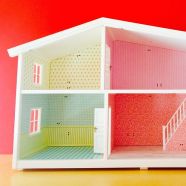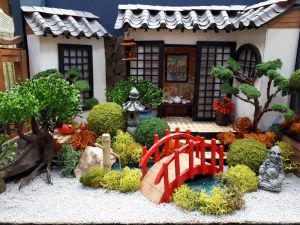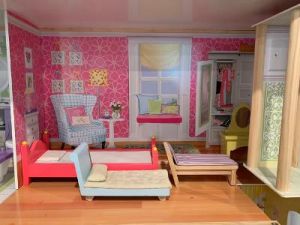
Lundby – Smaland Dollhouse. Photo by Studio Sarah Lou. https://tinyurl.com/7b7m9un5.
Share This
Print This
Email This
Reflections on Miniatures
South Writ Large posed a handful of questions to Dr. Merry White, professor of anthropology at Boston University, regarding people’s fascination with miniature items, the ways that they inspire imagination, their prominence in Japan, and the increasing popularity of tiny cooking shows.
Miniatures and Manipulation
When I was small, we lived in Chicago. I was allowed to go to the Museum of Science and Industry by myself by the age of eight, I think. I made a beeline for the Colleen Moore Dollhouse Collection. Dollhouses are the perfect universes for a little person. Looking at them is fun but manipulating them, even more. They are utopias, or dystopias, depending on a child’s psycho-emotional need to have a safe space or act out troubled feelings. In either case, the child is in control, and that’s one aspect of miniatures that makes them attractive.
You can if you like, make the dollhouse rooms reflect some imagined perfection—everything in its place. Or you can subvert the middle-class norms you were raised with and put the toilet in the living room. You’re in charge.
Miniatures and the Act of Compression
Making the large small gives power to the maker, the observer, the child. There are many ways in which this pleases: compressing a large thing, like all of Shakespeare (in thirty minutes) into a small thing, making all of Jane Austen into a dollhouse-sized book, taking all of history and making a fastforward video . . .
Another might be the time lapse photography of a tomato plant growing from seedling to fruit-bearing—compressing the growing cycle, almost miraculously.
Synecdoche, taking a small part for a whole, or an aspect for an entirety of meaning, is a kind of “miniaturization.”
Sometimes small is a matter of projection, desire, belief: you have to believe that that tiny Bible is really complete, or that it really is the Lotus Sutra inscribed on a grain of rice. Or that, as I did believe as a child, there are universes like ours, in a single cell on my own arm, with worlds like ours and a girl like me sitting on a bench in the park gazing at HER arm in which, of course there were myriads of universes . . . and on down, like the can of Dutch Cleanser on which the girl is depicted holding a can of Dutch cleanser with a girl holding . . .
Maps have always appealed to me as well, as they miniaturize landscapes, as they lead to imagining yourself on roads and in spaces. They turn the telescope around—you’re gazing from the large to the small instead of the reverse. They invert but also imply the large. Model trains the same. When I was young, those were for boys, and dollhouses were for girls but served perhaps the same function of control and power. And wonder. Diminutive does not diminish—it enlarges the imagination.
Walking into a cathedral you sense the space; above all, you sense the enormity of a space devoted to making you feel small, making you feel awe. I feel the same awe in the face of tiny things. It’s about you in the space as the observer as well as the object of the large or small thing’s working on you. You are meant to feel that awe and it works.
Miniatures and Japan
When I was a child, my toys seemed always to be stamped on the bottom “Made in Occupied Japan”—which I only vaguely related to the end of the war in which my uncles all fought, and more specifically related to Japan.
Small is connected to childhood but it is also connected to Japan where miniaturization has become almost stereotypically “Japanese”—think transistor radios, bento boxes, netsuke (which are fantastically detailed fobs for bags carried on one’s kimono sash, traditionally more male than female). And small landscapes in small gardens. The reference to the large (as in a raked sand garden representing a universe, or a small stone pile representing Mt. Fuji) in the small is the point.
The cultural power of “kawaii” or “cute” has been discussed as a kind of small is beautiful. Cute has transcended childhood in Japan—it’s not just for kids. Characters like Hello Kitty seem powerless (she has no mouth, for example) but they actually control us through their cute, small, and often female-coded essences.
Japanese food replicas, though not miniatures but “life-size” models, are a postwar requirement in many restaurant windows. These replicas (“sampuru” or “samples”) are to instruct the potential customer about what is available inside the restaurant and must be just about perfect in their representation of the food within. For the tourist trade, there are now shops where these “sampuru” made small are on sale as souvenirs, as keychains, refrigerator magnets, and the like: a bowl of ramen, a tempura shrimp, a nigiri sushi.

Miniature Makers and Collectors Club garden show 01. Photo by AMCSviatko. https://tinyurl.com/3amy7k9t.
Miniatures and Food
Recently there has been an online fad for miniature food, but the trick is, it’s real food and you can make it. You (or the surrogate hand on the video making the food) are large, but awkward as you are (think Gulliver in Lilliput) you can have the skill to work tiny tools and tiny amounts of ingredients and make something which, though tiny, is a tasty treat. It is interesting that the hand in many videos is a male hand, though interest in tiny is said to be more female than male, and though cooking is traditionally coded female too.










Thank you for helping me understand something to which I have given very little thought, but is of obvious importance to so many people.